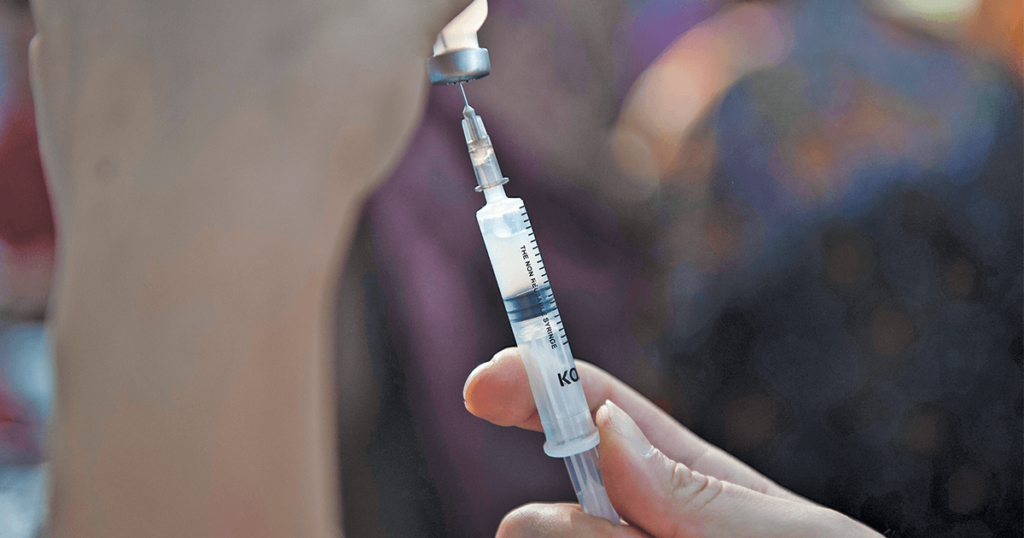

Meredith Wadman is a reporter at Science magazine and the author of The Vaccine Race: Science, Politics and the Human Costs of Defeating Disease, a Washington Post Notable Nonfiction Book of 2017. Her op-eds on biomedical issues have been published in The New York Times, The Washington Post, and Time. We asked her to pose four questions about the future of vaccines.
1. Driven by vaccine-resistant communities in New York state, U.S. measles cases reached a level in 2019 not seen since 1992. In Atlanta last February, the U.S. Centers for Disease Control and Prevention for the first time summoned police to protect a panel of vaccine experts during a public meeting packed with vaccine opponents. In California, state legislators were inundated by protesters as they moved last summer to tighten the rules on medical exemptions for school entry. Amplified by social media and animated by distrust of experts, vaccination opponents are spreading misinformation at a decibel level that belies their numbers: the most current CDC data show that just 1.3 percent of two-year-olds receive no vaccines. Still, the trend is worrisome. That number is four times higher than it was in 2001, and the proportion of kindergartners with vaccine exemptions—most of them nonmedical—reached 2.5 percent in the 2018–2019 school year. (Vaccination rates of 93 percent to 95 percent are required to keep measles at bay.) Across the Atlantic, people in Western European countries, led by France, had the lowest confidence in vaccine safety in a survey of 140 countries published in June in the Wellcome Global Monitor. So perhaps it’s not surprising that this year, the World Health Organization declared vaccine hesitancy a top-10 global health threat. In a postfact political climate, how do we battle vaccine skepticism?
2. Recent studies have used sophisticated climate and population modeling to predict the spread of the dengue and Ebola viruses as the climate warms. These add to a growing literature predicting that climate change, population growth, and urbanization could expose billions more people to potentially vaccine-preventable diseases in coming decades. European regulators approved a highly effective Ebola vaccine in November, but there is no widely approved vaccine for dengue, which is transmitted by mosquitoes. Nor are there licensed human vaccines for Zika, malaria, Lyme disease, and other insect-borne diseases, whose range is predicted to expand or shift, putting at risk immunologically vulnerable human populations. How can we drive development of vaccines to mitigate the effects of climate change on the spread of infectious diseases?
3. The decades-long quest for an HIV vaccine is already devilishly difficult. Now it may face a new, knotty challenge. The highly effective pill combinations known as PrEP (preexposure prophylaxis), already available in much of the developed world, are coming to sub-Saharan Africa, home to 70 percent of the 37 million people living with HIV. Taken daily, PrEP can powerfully thwart HIV transmission in people at high risk of becoming infected. But PrEP could also subvert the goals of vaccine trials, which depend on volunteers’ exposure to the virus. Three big trials in progress in sub-Saharan Africa today—two of vaccines and one of an injected antibody—are already fully enrolled. But one late-stage trial now launching in the Americas and Europe is screening out volunteers who want to begin taking PrEP on the spot. Going forward, will PrEP’s availability undermine recruitment for vital vaccine trials in sub-Saharan Africa and elsewhere? And will another approach that is coming soon—shots of long-acting, anti-HIV drugs injected a few times a year—further complicate efforts to test vaccines in human volunteers?
4. Fully deploying existing vaccines would mitigate a huge burden of illness worldwide. Consider that the rubella virus—the R in the MMR vaccine—still causes congenital rubella in an estimated 100,000 babies each year, leaving them, variously, with blindness, deafness, heart defects, and intellectual disabilities. Despite this, nearly a third of the world’s children aren’t vaccinated against rubella, also known as German measles. Meanwhile, reported cases of classical measles, which is particularly dangerous for malnourished children, doubled globally in 2018, spurred at least as much by poverty, war, and decrepit infrastructure as by vaccine resistance. The trend is worsening: more measles cases were reported to WHO in the first seven months of 2019 than in all of 2018. By October, an epidemic of more than 200,000 measles cases in the Democratic Republic of the Congo had killed more people, mostly children, than that country’s Ebola outbreak. In areas riven by war or poverty, strategies like vaccinating at refugee camps and being flexible about age requirements for vaccination—for example, administering catch-up vaccinations after periods of conflict—have proved effective. What other approaches can amplify the delivery of existing vaccines in the places that most need them?

